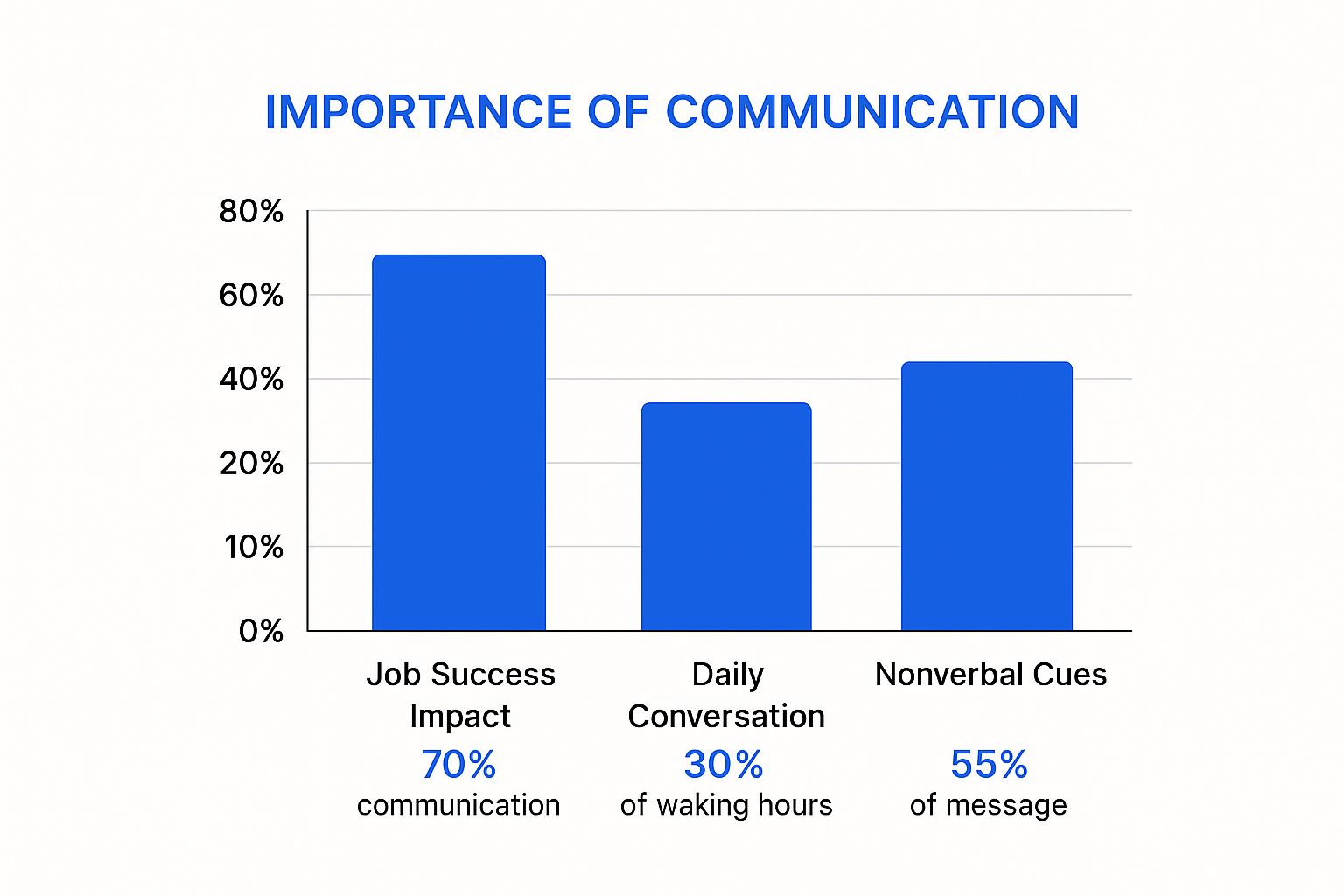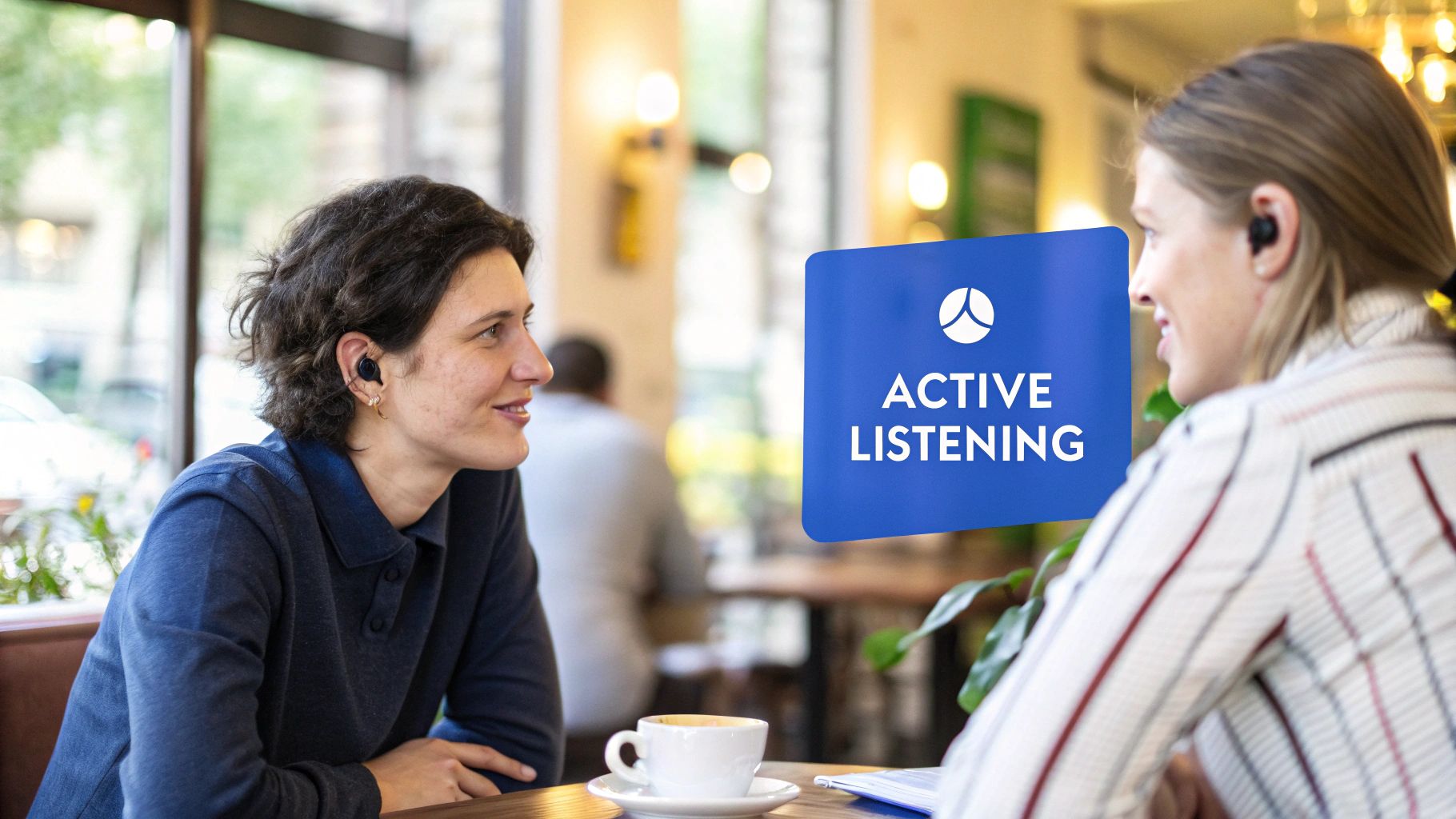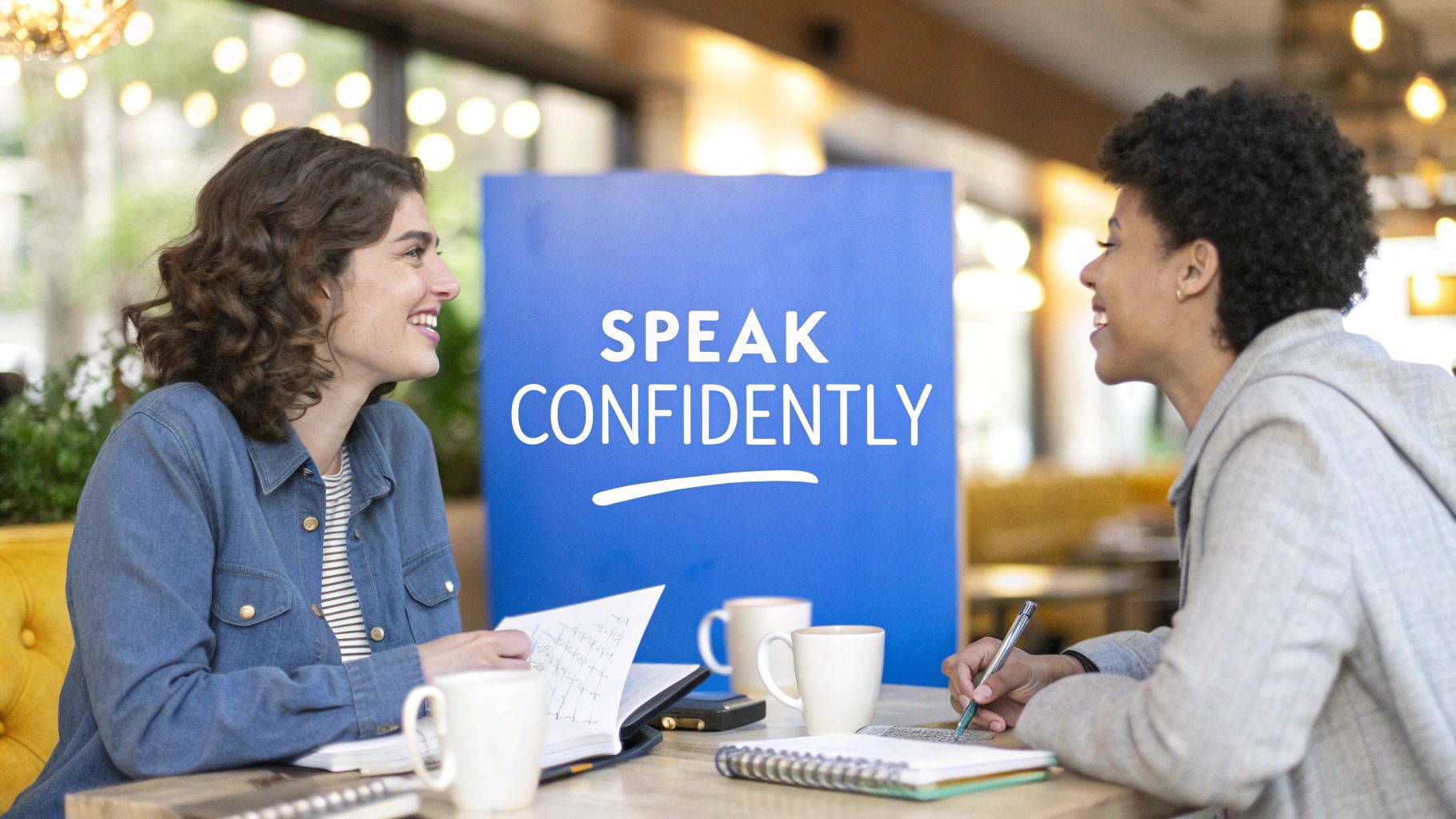Why Your Conversation Skills Actually Control Your Success
Many people think a great resume or deep technical knowledge is the secret to getting ahead. While those things are definitely part of the picture, the real driver behind major career moves is often something we overlook: the ability to communicate well. This isn't about being the loudest person in the room. It's about the subtle but powerful skill of sharing your ideas clearly, building genuine connections, and guiding discussions to positive outcomes. The reality is, your effort to improve conversation skills has a direct and massive impact on your professional life and even your personal happiness.
When you can navigate a conversation with confidence, you open doors that technical skills just can't. A casual chat at a networking event can turn into a new client. A performance review can become a stepping stone to a promotion. A tense disagreement can be smoothed out into a collaborative solution. The most successful leaders get this. They know that how you say something is often just as important as what you're saying. This is why you'll find so many high-achievers constantly working to sharpen how they talk and listen to others.
The Real-World Cost of Poor Communication
The fallout from weak communication skills is real and it hurts. Misunderstandings snowball into missed deadlines, team morale takes a nosedive, and potential revenue disappears. In fact, ineffective communication is a silent drain on businesses, costing them millions each year in lost productivity and avoidable mistakes. It's a major problem that too many organizations don't tackle head-on.
On the flip side, people and teams who make clear, empathetic dialogue a priority see incredible results. They build stronger professional relationships, create a foundation of trust, and work through problems more smoothly. The link between strong conversational chops and career growth isn't just a coincidence—it's a direct correlation. If you're curious about what sets top performers apart, you can dive deeper into our guide on what it takes to find success.
This infographic paints a clear picture of just how crucial communication is in every corner of our lives.

The data doesn't lie. What we say and how we say it really is the bedrock of our daily interactions and our ability to succeed professionally.
Why Employers Value Communication Above All
In a crowded job market, employers are looking for more than just a list of qualifications. They want people who can work well with others, make a persuasive case for their ideas, and connect with both coworkers and customers. It’s not surprising that effective communication is the single most desired skill by employers globally, with a staggering 57% naming it as the top quality they look for in new hires. Drilling down even further, 55% of recruiters highlight verbal communication as the most vital skill a candidate can bring to the table. You can explore these insights in the full communication statistics report.
To give you a clearer idea of what recruiters are looking for, here’s a breakdown of how different communication skills are prioritized when they're sizing up candidates.
Communication Skills Priority by Employers
A breakdown of which specific conversation and communication skills employers value most when evaluating candidates
| Communication Skill | Employer Priority Percentage | Impact Level |
|---|---|---|
| Verbal Communication | 55% | High |
| Presentation Skills | 47% | High |
| Active Listening | 36% | Medium |
| Written Communication | 28% | Medium |
This data confirms a simple truth: your ability to speak clearly, listen with intent, and present your ideas in a compelling way is your biggest professional advantage. Developing these skills isn't just a "nice to have"—it's an absolute must for anyone who's serious about hitting their goals. Every conversation is a new chance to build trust, show your value, and take a step closer to where you want to be.
Master Active Listening That Creates Real Connection

We’ve all been there: you're trying to share something important, and you see the person you're talking to zone out. Their eyes glaze over, and you just know they're waiting for a pause to jump in with their own story. This common habit is a surefire way to kill a genuine connection. To truly improve conversation skills, the biggest shift you can make is from focusing on speaking to mastering listening.
Exceptional listening isn't a passive act; it's an active, engaging process that makes the other person feel truly seen and heard. It's about more than just processing words—it’s about catching the emotion behind them and understanding the unspoken context. This is the secret ingredient that turns a forgettable chat into a memorable, trust-building interaction. Professionals in fields like therapy, sales, and negotiation rely on this skill daily because their success depends on making others feel understood.
Ditch the Rehearsal and Actually Listen
One of the biggest roadblocks to active listening is our own brain. While someone is talking, we're often busy scripting our response, thinking up a witty reply, or linking their experience to one of our own. This internal "rehearsal" pulls you out of the moment. To break this habit, you have to consciously quiet that inner monologue and redirect your focus to the speaker.
Your brain has a finite amount of processing power. If you’re dedicating 80% of it to crafting the perfect comeback, you only have 20% left to absorb what the other person is actually saying. Instead, make your primary mission to understand, not to reply. A practical trick is to try summarizing their key points in your head as they speak. This simple mental task forces your attention onto their message, not your own.
The Toolkit for Deeper Listening
Becoming a better listener comes down to a few specific techniques. These aren't complicated social hacks but simple adjustments in how you engage in a conversation.
- Paraphrasing for Clarity: This goes beyond simply parroting their words back. It's about rephrasing what you heard to confirm your understanding. For instance, you could say, "So, it sounds like you're feeling overwhelmed by the project because the timeline feels unrealistic. Is that right?" This shows you're not just hearing the words but also grasping the feelings and ideas behind them.
- Asking Deepening Questions: Steer clear of questions that lead to a simple "yes" or "no." Instead, ask open-ended questions that encourage them to share more. Swap out "Did you have a good vacation?" for "What was the most memorable part of your trip?" This signals real curiosity and opens the door for a much richer story.
- Embracing the Pause: Silence can feel uncomfortable, but it's an incredibly powerful tool. When someone finishes a thought, resist the urge to immediately fill the space. A short pause gives them a moment to collect their thoughts and perhaps add something important they might have otherwise held back. It also signals that you are thoughtfully considering what they've just said.
This screenshot from Wikipedia highlights the fundamental elements of active listening, showing it as a cycle of receiving information, understanding it, and then responding to confirm that understanding.

The main point is that listening is a multi-step activity. It requires both comprehension and confirmation, reinforcing that it’s something you do, not something that just happens.
Beyond the Conversation: Applying Listening to Your Network
These same principles of active listening are just as powerful for building connections online. "Listening" on social media means paying attention to what your community is discussing, understanding their pain points, and responding with genuine thought. If you want to dive deeper into this, check out our guide on proven social media engagement strategies.
By truly listening, you build trust and connection, which is the ultimate goal of any meaningful interaction, whether it happens face-to-face or screen-to-screen.
Build Unshakeable Confidence In Any Conversation
 Real conversational confidence isn't about having the loudest voice or dominating every chat. It’s that quiet self-assurance you feel when you're comfortable in your own skin, whether you're making small talk at a company happy hour or sitting down for a serious negotiation. So many smart, talented people freeze up in key moments, not because they lack great ideas, but because their own mental blocks get in the way. Learning to get past these hurdles is a huge part of how you improve conversation skills.
Real conversational confidence isn't about having the loudest voice or dominating every chat. It’s that quiet self-assurance you feel when you're comfortable in your own skin, whether you're making small talk at a company happy hour or sitting down for a serious negotiation. So many smart, talented people freeze up in key moments, not because they lack great ideas, but because their own mental blocks get in the way. Learning to get past these hurdles is a huge part of how you improve conversation skills.
This dread often comes from a fear of being judged or saying the wrong thing. But here's the thing: confidence is a skill you can build, not something you're born with. The goal isn't perfection; it's connection. You don't need to deliver a flawless monologue—you just need to connect with the other person and get your point across clearly.
The Mental Prep for Any Discussion
Before stepping into a conversation that feels a bit daunting, the best communicators prepare their mindset, not just their notes. They know what they want to accomplish but stay flexible in how they get there. This mental warm-up is what transforms an anxious, reactive speaker into a proactive, confident one.
- Set a Realistic Goal: Ask yourself, what’s the one thing I want to get out of this conversation? Maybe it's sharing a new idea, clearing up a misunderstanding, or just building a better relationship. Focusing on a single, clear objective keeps you from feeling overwhelmed.
- Visualize a Positive Outcome: Take a few quiet minutes to imagine the conversation going well. See yourself speaking calmly, listening with genuine interest, and moving through the discussion smoothly. This isn't just daydreaming; it's a technique athletes and performers use to build rock-solid self-belief.
- Embrace Imperfection: Let's be real—awkward moments happen. The secret isn't to avoid them entirely but to know how to handle them with grace. A simple, "Hang on, let me rephrase that," or a bit of lighthearted humor can instantly ease any tension and show you're relatable.
Projecting Confidence Through Non-Verbal Cues
Often, what you don't say speaks volumes. Your body language and tone of voice are responsible for a massive part of how people receive your message. Confident people get this, and they use non-verbal signals to their advantage. The way you carry yourself can earn you respect before you've even said a word. This is especially true when you're trying to build a strong presence, a skill you can learn more about by looking into some social media marketing best practices.
Here’s a quick guide to using your body and voice to project authentic confidence:
| Cue | Insecure Signal | Confident Signal |
|---|---|---|
| Posture | Slouching, crossing your arms, trying to look small. | Standing or sitting tall with an open posture, shoulders back. |
| Eye Contact | Eyes darting around, staring at the floor, or an intense, unbroken stare. | A steady, relaxed gaze that you break naturally from time to time. |
| Vocal Tone | Talking too fast, a high-pitched or shaky voice. | Speaking at a measured pace in a clear, steady tone. |
| Strategic Pauses | Filling every silence with "um," "uh," or "like." | Using deliberate pauses to add weight to a point or just to think. |
When you master these physical cues, you don't just look more confident to others—you actually start to feel more confident yourself. It's a powerful feedback loop. Your body informs your mind, so practicing confident posture can genuinely help lower your anxiety. Try picking one or two of these to focus on in your next conversation and see what a difference it makes.
Navigate Cultural Differences Like A Communication Pro

As our work and social circles expand across the globe, the ability to improve conversation skills goes beyond simply chatting with people from your own neighborhood. Mastering communication means you can adapt your style to connect with anyone, anywhere, without feeling like you're putting on an act. Recognizing the subtle but powerful differences in how people from various cultures communicate can be the key to building a strong partnership rather than accidentally causing offense.
This isn't about memorizing a huge list of cultural dos and don'ts. It's about developing what experts call cultural intelligence—a kind of flexible awareness that helps you read a situation and adjust your communication on the fly. For instance, in some cultures, being direct is a sign of honesty. In others, a more indirect approach is crucial for showing respect. A blunt "no" might be totally fine in one context, but in another, it could come off as rude. A more nuanced phrase like, "That will be difficult, but let me see what I can do," might be the expected response.
Understanding Core Communication Divides
Learning to navigate these differences begins with knowing where misunderstandings are most likely to happen. Cultural communication styles often diverge in a few key areas. Paying attention to these can give you valuable hints on how to adjust your own approach to build rapport more easily.
- Direct vs. Indirect: Some cultures value getting straight to the point, while others prefer to build context and tell a story before arriving at the main idea.
- Formality: The use of titles, professional etiquette, and the boundary between work and personal life can differ a lot.
- Non-Verbal Cues: Hand gestures, eye contact, and personal space are all shaped by culture. A friendly gesture in one country might be offensive in another.
- Attitude Toward Silence: In some cultures, a pause in conversation is a sign of thoughtful reflection. In others, it can feel awkward or signal disagreement.
Navigating Language Barriers with Grace
Even when everyone is speaking the same language, wires can get crossed. English is spoken by over 1.5 billion people and is often the language of global business, but the way it's used varies widely. Plus, to really connect with major markets, you might need some familiarity with other languages, like Mandarin Chinese with its 1.15 billion speakers or Spanish with 559 million. For a deeper look at how language impacts business, you can check out this analysis of communication statistics and their impact.
When you hit a language barrier, the best thing to do is slow down. Use simple, clear language and steer clear of idioms or slang that don't translate well. Patience and a willingness to rephrase your thoughts are your most effective tools.
Beyond language and cultural norms, individual personalities also play a huge part. To really become a communication pro, it's helpful to understand how different personality types interact. You can explore more on this by learning about Enneagram Type Compatibility. Building trust across cultures is less about being perfect and more about showing genuine respect and effort. When you show you're trying to understand and adapt, people are much more likely to forgive any small mistakes.
Transform Your Professional Communication Impact
Your career path often has less to do with what’s on your resume and more to do with how you handle yourself in conversation. In the professional world, your ability to communicate effectively is the engine that drives promotions, builds influence, and earns you a seat at the table. To truly improve conversation skills in a way that matters for your career, you have to look beyond basic small talk and focus on strategic, high-impact interactions.
Rising stars in any industry share a common trait: they know how to make every conversation count. They deliver feedback that inspires action instead of defensiveness. They lead meetings that end with clear takeaways, not more confusion. They build alliances and earn respect, often without needing a formal leadership title. This skillset is the invisible force behind successful salary negotiations, glowing performance reviews, and the ability to navigate tricky office dynamics with confidence.
The Financial Power of Clear Communication
The impact of communication isn't just about individual success; it directly affects the bottom line. The cost of miscommunication is staggering. In the UK and US alone, poor communication practices are estimated to cost companies $62.4 million annually per company due to lost productivity and preventable errors. Conversely, businesses that foster strong communication cultures often see 50% higher total returns than their peers. For more details on this, you can explore the financial findings on communication effectiveness.
This data highlights a critical truth: when you refine your professional communication, you’re not just helping yourself—you're contributing directly to your organization's success. This is a skill that executives notice and reward.
To illustrate this, here’s a look at how strong and weak communication practices can change a company's performance.
Workplace Communication Impact on Business Performance Comparison of business outcomes between companies with strong versus weak communication practices
| Communication Quality | Financial Impact | Employee Productivity | Error Rate |
|---|---|---|---|
| Strong | Companies with effective communication have a 50% higher total return to shareholders. | Teams are up to 25% more productive, leading to better project outcomes. | Significantly lower; fewer mistakes from misunderstood instructions. |
| Weak | An average loss of $62.4 million per company annually due to miscommunication. | Reduced efficiency and motivation, leading to missed deadlines. | Higher, resulting in rework, wasted resources, and potential safety issues. |
The takeaway is clear: investing in communication skills pays real dividends, both for individual careers and for the company as a whole.
From Good to Great: Key Workplace Scenarios
Advancing your career means mastering specific types of professional conversations. Let's move from theory to practice with actionable strategies for common yet crucial workplace situations. For those aiming to seriously improve workplace communication, focusing on these areas can yield significant results.
Here’s a breakdown of how to approach these high-stakes conversations:
- Delivering Feedback: Instead of focusing only on what went wrong with "you" statements that sound like accusations ("You missed the deadline"), frame it collaboratively. A better way is starting with a shared goal and using "I" statements, like "I noticed the report was late, and I was concerned about our project timeline. How can we make sure this doesn't happen next time?"
- Leading a Meeting: Don't let the conversation drift without a clear agenda. State the meeting's objective right at the start. Keep the discussion focused, gently steer it back on track if needed, and always end with clear, assigned action items.
- Disagreeing with a Superior: It can be intimidating, but staying silent and resentful isn't a solution. Neither is being confrontational. Try asking clarifying questions to fully understand their viewpoint first. Then, present your perspective as a different option to consider, not a direct challenge. For instance, "I see your point about that approach. Have we also considered...?"
Excelling in the Remote Workplace
Today, a lot of our professional communication happens through a screen, which brings its own unique set of challenges. Building trust and making an impact remotely requires a deliberate approach. A vague email can cause hours of confusion, while a disengaged presence on a video call can make you seem uninterested.
Here are a few tips to sharpen your digital communication:
- Write emails that get responses: Keep them concise, use a clear subject line that says what you need, and bold key questions or deadlines so they don't get missed.
- Be memorable in virtual meetings: Look at your camera when you speak, not just at the faces on your screen. This creates a sense of direct eye contact. Use concise language and resist the urge to multitask.
- Build trust across screens: Acknowledge messages promptly, even if it's just with a quick "Got it, thanks." This simple act creates a sense of reliability and shows that you're engaged.
These skills are fundamental for anyone managing a team or project online. In fact, they share many principles with effective online community management, where clarity and consistent engagement are essential. Mastering these skills makes you a more valuable and visible team member, regardless of your physical location.
Handle Difficult Conversations Without Breaking A Sweat
The conversations we often put off—like asking for a raise, sorting out a conflict with a family member, or giving tricky feedback—are usually the ones that shape our relationships and careers the most. These aren't just simple chats; they are high-stakes moments that demand a special kind of skill. While it's tempting to dodge the discomfort, learning to manage these situations with confidence is a massive leap forward to improve conversation skills. The objective isn't to "win" but to work through the tension in a positive way, turning a potential fight into a problem-solving team effort.
A classic mistake is diving into these talks when you're already upset and unprepared. The trick is to switch from reacting in the moment to planning ahead. Before you say anything, figure out your main goal. What does the best possible outcome look like? It's almost never about proving you're right. Usually, it's about making sure you're heard, finding some common ground, or figuring out a way to move forward together.
De-Escalate Tension with Strategic Language
The words you pick can either add fuel to the fire or help calm things down. When feelings are running high, a few simple language tweaks can make the other person less defensive. One of the most powerful moves is to trade accusatory "you" statements for descriptive "I" statements.
For instance, instead of saying, "You never listen to my ideas in meetings," which just makes people put their walls up, try framing it from your point of view: "I feel discouraged when I share ideas in meetings and don't get a chance to explain them fully." This way, you're not placing blame. You're just describing how the situation affects you, which makes it much easier for the other person to listen. It turns the conversation from being about fault to being about feelings, which opens the door to a real discussion.
A Framework for Constructive Disagreement
When you know a conversation is going to be tough, having a basic structure can keep you on track and calm. Think of it as a guide to help you navigate the emotional parts of the discussion.
| Step | Action | Example |
|---|---|---|
| State Your Shared Goal | Kick things off by pointing out your shared interest in a good result. | "We both want this project to succeed, so I'd like to talk about how we can work together more smoothly." |
| Describe the Behavior | Stick to the facts without adding your own spin or judgment. | "In our last three team calls, I was interrupted while I was presenting the data." (Not: "You're always cutting me off.") |
| Explain the Impact | Use "I" statements to share how the behavior is affecting you or the work. | "When that happens, I lose my train of thought and feel like my contribution isn't valued." |
| Make a Request | Be clear about what you'd like to see change in the future. | "Going forward, could we make sure everyone gets to finish their point before we jump in with questions?" |
This framework isn't a script you have to follow word-for-word, but it’s a great tool to keep the conversation focused on the problem, not the person. It helps you stay professional even when you're talking about sensitive stuff. Of course, how you present yourself during a conflict is also important. Many of the same ideas about clear, calm communication apply to your public image, which you can read more about in our insights on social media reputation management.
Ultimately, handling difficult conversations is about staying calm when others lose control, finding common ground, and turning a dreaded confrontation into a chance to make a relationship stronger.
Your Personal Conversation Skills Development Blueprint
Theory is great, but real progress happens when you put knowledge into practice. To actually improve conversation skills, you need a plan—a realistic, structured approach that turns good intentions into lasting habits. Think of the next month as your personal communication workout. By focusing on specific exercises, you can systematically build conversational muscle, moving from the basics of listening to more advanced ways of building influence and connection.
This isn't about becoming a different person overnight. It's about making small, consistent efforts that add up to a major breakthrough in your confidence and ability. The key is to create practice opportunities within your daily routine without it feeling forced or awkward.
Building Your Practice Routine: A Four-Week Focus
A structured plan helps you avoid feeling overwhelmed. By breaking down the complex world of communication into weekly themes, you can focus your energy and see your progress more clearly. This creates a feedback loop where each small win builds momentum for the next challenge.
Here’s a sample structure you can adapt for your own development:
Week 1: Foundational Listening. Your mission this week is to speak less and hear more.
- Daily Exercise: In at least one conversation each day, try to ask three deepening questions (like "What was that like?" or "How did you come up with that idea?") before you share your own related story.
- Challenge: Try the "summary technique." After a friend or colleague shares something complex, say, "So, if I'm hearing you right, it sounds like..." and paraphrase their main point. Notice how it changes the dynamic.
Week 2: Confident Openings. This week is all about taking the first step and initiating conversations.
- Daily Exercise: Give one genuine, specific compliment to someone you don't know well (e.g., a barista, a coworker from another department). The goal isn't a long chat, just breaking the ice.
- Challenge: Attend one low-stakes social or professional event with the goal of having three separate, brief conversations. Your only metric for success is starting them.
Week 3: Navigating Disagreement. Focus on staying calm and constructive when opinions differ.
- Daily Exercise: Find a minor point of disagreement in a conversation (like a movie review or a news story) and practice validating the other person's view ("I can see why you'd think that...") before stating your own.
- Challenge: If a more significant disagreement comes up, consciously use "I" statements ("I felt confused when...") instead of "you" statements ("You weren't clear.").
Week 4: Storytelling and Connection. Now, you’ll work on being a more engaging speaker.
- Daily Exercise: Think of one interesting thing that happened to you during the day. Practice telling it as a concise, one-minute story to a friend or family member.
- Challenge: In a conversation, actively listen for an opportunity to share a relevant, brief personal story that shows empathy or adds value to the discussion.
Measuring Your Progress and Getting Feedback
How do you know if you're actually getting better? Keeping track of your efforts is essential. You can use a simple journal to note your daily exercises and how they felt. Did you feel more or less anxious? Did the conversation flow better? These personal notes are just as important as hard data.
This diagram shows the core parts of interpersonal communication, highlighting the sender, receiver, message, and the all-important feedback loop.
This visual is a great reminder that communication is a two-way street. Getting feedback isn't optional; it's a necessary part of the process.
To get that vital feedback, ask a trusted friend or mentor for their honest observations. You could ask, "I'm working on my communication skills. Is there anything you've noticed about how I come across in conversations?" Their insights can be incredibly valuable. Honest feedback, even if it’s a little hard to hear, is the fastest way to spot your blind spots and speed up your growth.
Ready to stop guessing and start growing your audience on X? Reply Guy pinpoints the perfect conversations for you to join, turning your engagement into real followers. Get lifetime access with a one-time purchase and start building your influence today.
